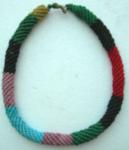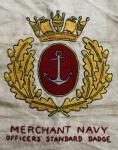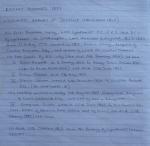-
Posts
13,225 -
Joined
-
Last visited
-
Days Won
22
Content Type
Profiles
Forums
Blogs
Gallery
Events
Store
Everything posted by Mervyn Mitton
-

Zulu items
Mervyn Mitton replied to helen's topic in Great Britain: Militaria: Badges, Uniforms & Equipment
-

Zulu items
Mervyn Mitton replied to helen's topic in Great Britain: Militaria: Badges, Uniforms & Equipment
-

Zulu items
Mervyn Mitton replied to helen's topic in Great Britain: Militaria: Badges, Uniforms & Equipment
-

Zulu items
Mervyn Mitton replied to helen's topic in Great Britain: Militaria: Badges, Uniforms & Equipment
Back on Page 2 , Mike Huxley showed some interesting beadwork brought back from Zululand over 100 years ago. I promised to add some more - herewith. There are two hanging necklaces , plus some neck bands and arm/ankle bands. The bands were often worn by the warriors and the neck example with the several folds is a particularly good example. Beads were bought from traders, but in the early days the string was woven from the stem of a palm leaf. -
Hi - Thomas the Tank - I thi nk this new 'nick' will stick with you. Have you told your family ? Paint job is excellent.
Now I know what this panel is for ... -
This is an original Ball and Chain. Would be locked around an ankle and the 56 lb. (26 kgs) ball carried in the hands. Would be used for dangerous prisoners and also for going to the Assize Court. About 150 years old - only carronades - short rage cannons with a big bore - fired anything as big. When my book first came-out it was sold Worldwide and a great old man (I seem to remember he was in his late 80's) living in Ontario, Canada, got very excited and started writing to me. He was sure that the example in the Ontario Museum was larger and even at his age, marched down there - insisted they take it out of the display case and weigh it - so that he could tell me he had found a larger one. He just wanted to add to the knowledge of the book and I wrote to him for some time. Yes - their's is larger - I think it was 66lb. (32 kgs.) Must have been difficult to move with it in your hands.
-
Known as 'ASSIZE CHAINS' these were developed to control difficult prisoners over journeys of distance. The old Court system meant a senior judge travelled on a Circuit around the area of his jurisdiction. He went in great style - escorted by mounted police and with a retinue of servants. Whole buildings would be reserved for his use. However, it usually meant that he sat in Court only a few times a year - and only in the main town of a County. For example - in Dorset, he would have court only in Dorchester. This meant that prisoners had to be brought considerable distances - and often by horse carriage or, railways. The chains consisted of a pair of handcuffs, on a longish chain. From this ran chains to ankle cuffs and in addition - two 28 lb. (27kgs.) were on chains from the wrist chain. These had to be hand carried. The result was that not many prisoners escaped... When I bought these, it was from a man who answered an advt. I had in the paper. He asked me to meet him in a pub carpark on a Sunday afternoon. When I arrived he had the chains stretched out on the ground and over 50 people standing in amazement. Imagine how embarrassed I was to negotiate purchase - they didn't know I was a police officer and must have thought I was into those strange things people do with chains !!!!!!
-
Start of a short series on early forms of restraint of prisoners. Having said that, means of confining a prisoner have not really changed very much from the early idea of a length of raw hide and two handles - wrapped around the wrists it could be tightened and used as a leading cuff. Metal handcuffs - with separate locks really start from the 17th Century (1600's) and variations began almost immediately. There are several extremely rare pieces on this picture. Centre - 2nd. from top : Early 19th. C. leading cuffs. One around the prisoner - and the side that opened, on the Constables wrist. 2nd. down on right : Majority of opinion is that these were invented to hold Boer Prisoners of War between 1899-1902. There is a double lock and the key has double ends. You had to unscrew the plug and then this gave access to the lock. After the Boer War they continued in use in British Prisons for dangerous prisoners. 3rd. down on right: The original pattern from 1829 when the first Metropolitan Police 'marched-out'. Very rare - they were carried in the back pocket of the swallow tailed coatee. All others are variations on the 'D' shaped handcuffs, which were in use for nearly 200 years. Since I no longer have many of these , I have taken the picture - and the next two - from my book. 'The Policeman's Lot'. Mervyn Mitton. Quiller Press . 1985. Copies can be bought on line - type on book title.
-
Douglas - thought I would 'alert' you in case you - or any other members - might have an interest in an original 1899 Mauser 'Broomhandle' wooden stock/case. I would think they could be fairly rare on their own. Will put on the For Sale section later today. The lady who brought it in said it had been complete and in the family for years - however, the pistol had been stolen.
-
Brian - absolutely fascinating - I had no idea that these medals existed. The modern Police history of a great Country and exactly what I think we all hoped for with the the new sub-forum. I agree with you that the quality is local - but in no way does that subtract from them - what I also, do find interesting is that, whilst living in Canada,you have sought these out and built-up a substantial collection. One thing that does come to me from this post - is that we desperately need an index on each sub-Forum. Information , such as this, is valuable for future collectors and it is a pity that it should become buried and not easily found. I'll suggest it on the Lounge.
-
Interesting group to a World War 2 Merchant Navy Officer - he died only last November, aged 92. Unusually, there are five Stars - the max. you could be given - other entitlements were as bars or, rosettes. He served throughout the War as an Engineer on board BEN Lines ships - he was on Russian Convoys and as can be seen, was all over the World. Details are - Frederick Walter LEEDER 4/1/1916 - 23/11/2008. After the War he left Ben Line and joined Cunard. I think his rank arm rings - he is on the right in the photo - show him as a 2nd. Engineer Officer ? These medals were a replacement in 1989 after the first issue were lost. However, being un-named this is not important and the issue paperwork substantiates his service. The Merchant Navy crest - sewn onto a backing , was done by his wife. The two lapel badges - one is for the SS. UGANDA. Not sure when he served on her - presuming that he did ? The other is an Air League badge and I think pre-war.
-
Most impressed and great that you took the time to post them. I'm trying to order the ones you posted earlier and when the new book on Aust. badges is published - perhaps someone could alert us with the publisher's name ? Rob - since you have the books - see if you can find the badge Tom described ??? We seem to have - at last - some good Aussie posts - we must try to keep them going. We may be out numbered - but, never out classed ..............
-
Hi- Graham. Superb drum - pity they cut-it down. Interesting that the Battle Honours show Modder River and South Africa. Hawkes have now become Boosey and Hawkes - that is, if they are still in business. Did you see the side drum I posted for the Royal Irish Regt. - made for the 1911 Coronation - that was a Hawkes.
-
Paul - I hope these fit in with the good thread you have going. They are all for the South African Forces - with all the changes someone more up-to-date will have to tell us if they are still current. The top one is a Warrant Office Class 1 in the Sth. African Medical Services. The smaller one for a W.O. 2.
-
Thanks, Rob. I would like copies of all of them - if you have them, do they have an ISBN in the front pages. Would help to locate them. They might of course, be old books and hard to find. Mervyn. Tony - they must come on the market - perhaps Stuart can help - he has a lot of contacts in the helmet collecting fields - drop him an IM. I was always pleased thet I kept my Qld. Regt. one - they are quite hard to find outside of Aussie.
-
Sorry , Brian - I wasn't trying to 'trick' you - I realised at once that you also wanted others to write. There is just so much knowledge within the membership, but, people seem nervous to post ''in case they have it wrong'' - or, their English is not perfect , my German and French will be much worse ! So what if they aren't always correct - we can all add constructive comment - I'm always pleased if I make a mistake and someone points it out - I certainly don't get upset - we can't know everything. ( Just try to give the impression we do......)
-

An interesting machine gun photo
Mervyn Mitton replied to Brian Wolfe's topic in Firearms & Ordnance
The stock does have a weird shape and seems to attach under the base of the weapon - perhaps it had an alternative stock for other uses ?


















